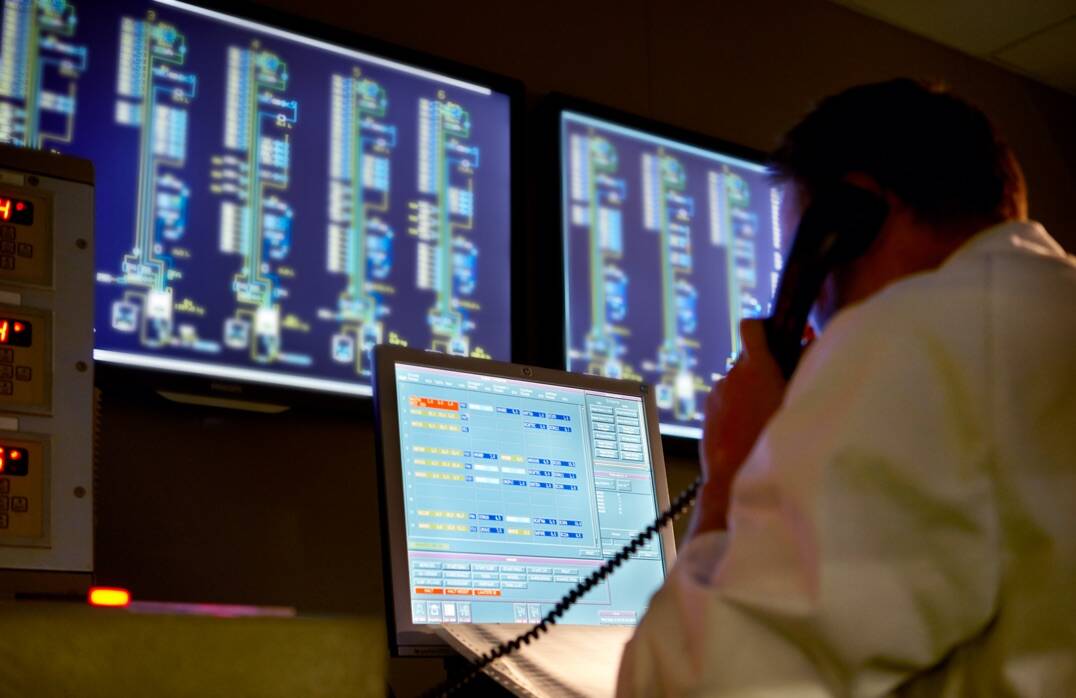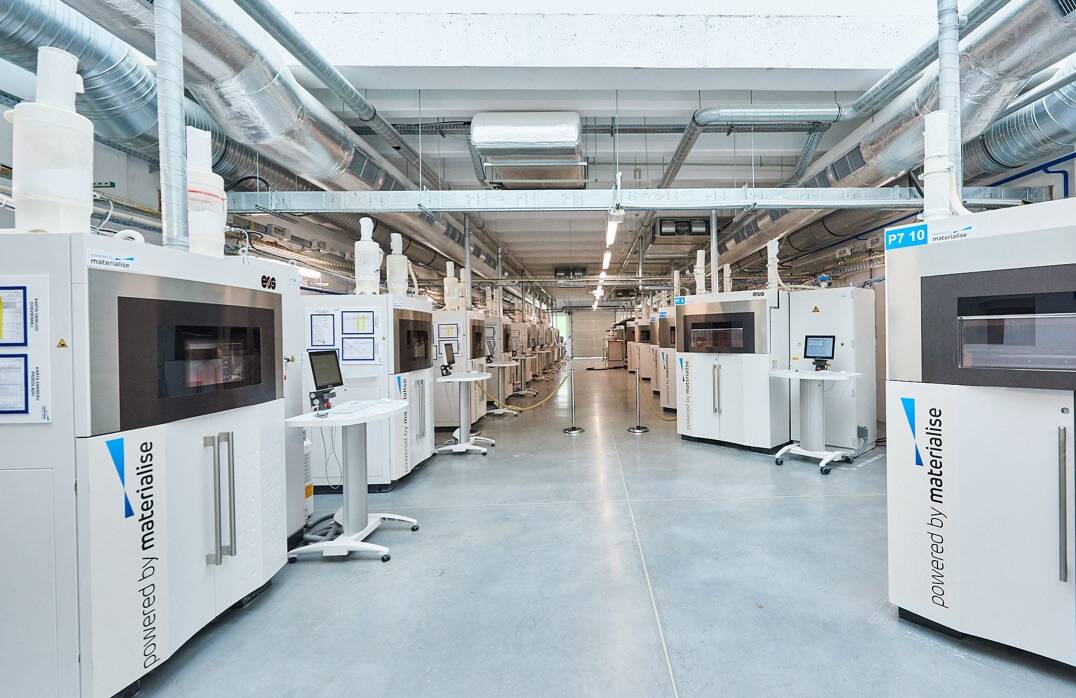
A common and widespread impetus for digitisation is the gigantic paper mountain that many companies struggle with. Becoming a paperless factory proves both a concrete target and an ideal step towards further digitisation.
Guy De Winne (ST Engineering): “Achieving a ‘paperless factory’ became the main reason why many factories launched a digitisation process around 2005, to the extent that it almost became a buzzword. But for us, it was real goal that we also achieved. SAP came to be at the heart of our processes and replaced all paper documents.”
Part 1
The transition towards a digital factory usually starts with a concrete challenge. Companies often want to increase their efficiency, improve their production process or streamline the various departments of the company.
Connectivity without paper
Although Duracell only launched its digitisation process three years ago, the company wanted to get rid of its mountain of paperwork in the near future. Jan Casteels: “The main challenge in 2018 was our giant mountain of paperwork. We wanted to eliminate this by increasing the connectivity between departments and roles. For example, some batteries need to be converted to non-standard specifications at the customer's request. We used to monitor these instructions on paper, during both production and quality control. That took up a huge amount of time.”
For Ontex, the paper mountain did not directly give rise to the desire to digitise but was a symptom of inefficient processes. Jef Monballyu: “Production orders had been rolling out of our ERP software for years. Reference lists were printed out and passed to the production floor. Long story short: it was a manual, labour-intensive and above all error-prone process that didn’t offer much added value. Today, this process has been fully automated.”

We wanted to eliminate our mountain of paperwork by increasing the connectivity between departments and roles.”

Production orders on paper formed a manual, labour-intensive and above all error-prone process that didn’t offer much added value.”

Belgian manufacturing companies have to compete against countries in which labour is much cheaper. In the case of digitisation, innovation is not the goal in itself but a means to the end of increasing competitiveness. Through better, faster or higher quality production.
Increasing competitiveness through digitisation
Duracell has four factories all over the world, one of which is in Aarschot. The Belgian factory competes internally with its predominantly Asian sister companies. In the whole of Europe, there are only three factories that produce batteries. Duracell Belgium has managed to remain competitive thanks to digitisation.
Jan Casteels: “In Belgium, the cost structure of wages is a disadvantage that we need to compensate for. Although it is offset to some extent by our central position, this is gradually becoming less relevant. Non-perishable products such as batteries can now be exported cheaply all over the world. The fact that we were able to digitise so quickly gave us another competitive advantage. Our highly trained staff and innovative market gave us a head start. We identified a few loss-making factors and were able to quickly eliminate them.”
Duracell is an outsider in the Belgian manufacturing industry, as it is one of the few factories that is competitive in mass production.
Geert Jacobs: “We usually see very specific and small-scale products in the Belgian manufacturing industry. Duracell forms an exception to this rule. Digitisation allowed Duracell Belgium to produce more cheaply than Chinese factories. That is truly impressive.”
So how did the factory achieve this? Whereas the machines used to stop about 600 times a day, this figure has now been reduced to around twenty times a day. These downtimes are also getting shorter and shorter. On tablets, employees immediately have all the relevant information at their disposal. On-the-job training takes place in a completely wireless and contactless way, using helmets. Duracell has streamlined all the processes in real time, improving both production speed and quality. Duracell is therefore a good example of how a Belgian manufacturing company can remain competitive as a result of digitisation, even in the case of mass production.
Specific versus large-scale production
Most companies already have software systems for managing data, such as an ERP (Enterprise Resource Planning) for stock management or CRM (Client Relationship Management) for client data. The big problem is that these kinds of systems are not connected, which leads to data silos. The challenge of connecting all these silos and centralising the information sounds similar for all the participants.
From data silos to MES
ST Engineering had been using SAP as an ERP system and made the transition to MES without external help.
Guy De Winne: “SAP got up and running smoothly, but the planning remained a sticking point. In order to take suppliers, clients and our own capacity into account, we still needed to draw up our planning days, or even weeks, in advance. We therefore started looking for a way to plan in real time and on a flexible basis. Our SAP specialist knew the production floor and our IT systems inside out. He was able to implement the revised planning system within the functionalities of SAP. That’s how we built our own MES.”
Creating an MES within existing software
A factory collects a huge amount of data: from the machines, different departments and even the entire value chain from supplier to customer. The first step towards the improved management of all the information within the factory is to switch to an MES: Manufacturing Execution System.
Pepijn Verhaeghe (Vandemoortele): “By means of an MES, we are succeeding in joining the separate links of our production process to form a single integrated chain. As well as operational efficiency, both we and our clients derive added value from this in terms of traceability, quality and waste reduction.”
“However, much greater benefits could still be obtained from the data that flows from the machines and processes via the MES. For the time being, the analyses and interpretations are still mostly carried out by people. Adding artificial intelligence in the long term will make our systems self-learning.”

Much greater benefits could still be obtained from the data that flows from the machines and processes via the MES"

Once data silos have been connected, a huge amount of information is revealed. This information is often very diverse and not easy to standardise. It is a major challenge to analyse this data and then take the right action. The concrete objective for factories of the future is to present the right employee with the right data at the right time. This will allow them to make targeted decisions or take steps towards improvement.
Unlocking the power of data
Step 1: collecting existing data
The digitisation of the processes at Ontex ensured that both the production and support services now form a single chain. This yields a lot of information, among other things in the form of data from their machines. Ontex quickly discovered the potential of this data.
Jef Monballyu: “Not only did we switch from paper to digital checklists, we also introduced a camera system for the visual quality control. At strategic locations on the production line, each product is photographed and compared with a digital template.”
Ontex also continuously monitors the machinery itself, both in terms of technical performance and maintenance as well as in terms of energy consumption. All these processes generate a great deal of data. It’s a massive task to draw the right conclusions from it all.
Jef Monballyu: “Which machine occasionally produces deviating products? Why do we get more error messages and downtimes on one production line than on another? But also: are we checking the products for the right parameters? After all, you can only be a smart factory when you base your decisions on information from all these data streams.”
When Materialise went public in 2014, it was faced with the challenge of centralising all its data.
Bart Van der Schueren: “The IPO meant we had to consolidate all our information and data and translate it transparently for the market. Due to the complexity of our database, we had previously decided to split it up. The challenge that arose after the initial IPO was how to merge our data silos once again. Not easy, because how do you merge large amounts of data into one? And in a cost-effective way? Our digitisation process will never be finished, as you can see. You must always be willing to adapt your digital infrastructure to the current needs and opportunities.”

You must always be willing to adapt your digital infrastructure to the current needs and opportunities.”


You can only be a smart factory when you base your decisions on information from all these data streams.”

Maar wat leveren die data nu concreet op? De tweede horde die maakbedrijven nemen, is die data op een overzichtelijke en efficiënte manier aan de medewerkers presenteren.
Guy De Winne (ST Engineering): “De voorbije jaren verzamelden we heel wat data, maar die zat verspreid over verschillende databases, zowel vanuit de productie en machines als uit de ondersteunende diensten. We wilden ervoor zorgen dat alle informatie gecentraliseerd werd in één datacube met verschillende views. Zodat elke medewerker vlot de juiste informatie voor zijn functie uit die centrale database kan halen.”
We had collected a lot of data over the past few years, but it was spread across various different databases.”

Step 2: making efficient use of data
Duracell was also faced with a huge influx of data.
Jan Casteels: “We combined information from all corners of the factory and from different systems into a single platform. We can now display all the data from the production lines, the Manufacturing Execution System, the quality control and the ERP system in a single visual overview.” The result? The factory in Aarschot is the most innovative in the entire group.
But what are the concrete benefits of this data? The second hurdle faced by manufacturing companies is to present the data to employees in a clear and efficient way.
Guy De Winne (ST Engineering): “We had collected a lot of data over the past few years, from both the production and machines as well as the support services, but it was spread across various different databases. We wanted to ensure that all the information was centralised in a single data cube with different views. This would allow each employee to easily retrieve the right information for his or her position from this central database.”
Materialise had a concrete logistical need to manage their information digitally.
Bart Van der Schueren: “Every year, we print thousands of patient-specific implants that are impossible for the human eye to distinguish between. This is why we developed our own technology to keep everything on the right track logistically and monitor our processes.
One year after the company was set up, we created a database for all our client data. It was actually a CRM system before that kind of thing really existed. Although some high-level ERP and CRM packages did exist at that time, they were only affordable for large companies. As a small SME, we did everything ourselves. We are constantly expanding our software packages, for example to include stock management or external CRM packages. This digitisation is a continuous development process that is still ongoing today.”
Data as a logistical necessity
“Our growth was stalling due to the scarcity of technical lab profiles on the labour market. But if you encrypt that know-how in your systems and processes as much as possible, you can break open the talent pool. These days, around half of our employees no longer need a technical lab background.”
But things didn’t just stop at process automation. Five years ago, Lavetan started the process of robotisation, mainly to ensure 24/7 business continuity. Jan Robrechts: “For about two years now, we have been in the ‘intelligent transformation’ phase. Not working harder but smarter is now our motto.”
We drew up a single automated value chain, from the sample's departure from the client right through to the invoice.”

Part 1 - Drivers

Paperless factory

Staying competitive
Breaking open data silos

Unlocking the power of data

Automating processes

It was the move to a new, more spacious location that marked the start of Lavetan’s digital transformation.
Jan Robrechts: “We drew up a single automated value chain, from the sample's departure from the client right through to the invoice. In our value chain, the end of one process phase automatically triggers the next. The intelligence is therefore encrypted in the system rather than the minds of the employees. After all, they were becoming increasingly difficult to find.
Automating processes

Part 1
The transition towards a digital factory usually starts with a concrete challenge. Companies often want to increase their efficiency, improve their production process or streamline the various departments of the company.
A common and widespread impetus for digitisation is the gigantic paper mountain that many companies struggle with. Becoming a paperless factory proves both a concrete target and an ideal step towards further digitisation.
Guy De Winne (ST Engineering): “Achieving a ‘paperless factory’ became the main reason why many factories launched a digitisation process around 2005, to the extent that it almost became a buzzword. But for us, it was real goal that we also achieved. SAP came to be at the heart of our processes and replaced all paper documents.”
Connectivity without paper
Although Duracell only launched its digitisation process three years ago, the company wanted to get rid of its mountain of paperwork in the near future. Jan Casteels: “The main challenge in 2018 was our giant mountain of paperwork. We wanted to eliminate this by increasing the connectivity between departments and roles. For example, some batteries need to be converted to non-standard specifications at the customer's request. We used to monitor these instructions on paper, during both production and quality control. That took up a huge amount of time.”

We wanted to eliminate our mountain of paperwork by increasing the connectivity between departments and roles.”

For Ontex, the paper mountain did not directly give rise to the desire to digitise but was a symptom of inefficient processes. Jef Monballyu: “Production orders had been rolling out of our ERP software for years. Reference lists were printed out and passed to the production floor. Long story short: it was a manual, labour-intensive and above all error-prone process that didn’t offer much added value. Today, this process has been fully automated.”
Production orders on paper formed a manual, labour-intensive and above all error-prone process that didn’t offer much added value.”

Belgian manufacturing companies have to compete against countries in which labour is much cheaper. In the case of digitisation, innovation is not the goal in itself but a means to the end of increasing competitiveness. Through better, faster or higher quality production.
Increasing competitiveness through digitisation
Duracell has four factories all over the world, one of which is in Aarschot. The Belgian factory competes internally with its predominantly Asian sister companies. In the whole of Europe, there are only three factories that produce batteries. Duracell Belgium has managed to remain competitive thanks to digitisation.
Jan Casteels: “In Belgium, the cost structure of wages is a disadvantage that we need to compensate for. Although it is offset to some extent by our central position, this is gradually becoming less relevant. Non-perishable products such as batteries can now be exported cheaply all over the world. The fact that we were able to digitise so quickly gave us another competitive advantage. Our highly trained staff and innovative market gave us a head start. We identified a few loss-making factors and were able to quickly eliminate them.”
Specific versus large-scale production
Duracell is an outsider in the Belgian manufacturing industry, as it is one of the few factories that is competitive in mass production.
Geert Jacobs: “We usually see very specific and small-scale products in the Belgian manufacturing industry. Duracell forms an exception to this rule. Digitisation allowed Duracell Belgium to produce more cheaply than Chinese factories. That is truly impressive.”
So how did the factory achieve this? Whereas the machines used to stop about 600 times a day, this figure has now been reduced to around twenty times a day. These downtimes are also getting shorter and shorter. On tablets, employees immediately have all the relevant information at their disposal. On-the-job training takes place in a completely wireless and contactless way, using helmets. Duracell has streamlined all the processes in real time, improving both production speed and quality. Duracell is therefore a good example of how a Belgian manufacturing company can remain competitive as a result of digitisation, even in the case of mass production.
Most companies already have software systems for managing data, such as an ERP (Enterprise Resource Planning) for stock management or CRM (Client Relationship Management) for client data. The big problem is that these kinds of systems are not connected, which leads to data silos. The challenge of connecting all these silos and centralising the information sounds similar for all the participants.
From data silos to MES
A factory collects a huge amount of data: from the machines, different departments and even the entire value chain from supplier to customer. The first step towards the improved management of all the information within the factory is to switch to an MES: Manufacturing Execution System.
Pepijn Verhaeghe (Vandemoortele): “By means of an MES, we are succeeding in joining the separate links of our production process to form a single integrated chain. As well as operational efficiency, both we and our clients derive added value from this in terms of traceability, quality and waste reduction.”
“However, much greater benefits could still be obtained from the data that flows from the machines and processes via the MES. For the time being, the analyses and interpretations are still mostly carried out by people. Adding artificial intelligence in the long term will make our systems self-learning.”

Much greater benefits could still be obtained from the data that flows from the machines and processes via the MES"

Creating an MES within existing software
ST Engineering had been using SAP as an ERP system and made the transition to MES without external help.
Guy De Winne: “SAP got up and running smoothly, but the planning remained a sticking point. In order to take suppliers, clients and our own capacity into account, we still needed to draw up our planning days, or even weeks, in advance. We therefore started looking for a way to plan in real time and on a flexible basis. Our SAP specialist knew the production floor and our IT systems inside out. He was able to implement the revised planning system within the functionalities of SAP. That’s how we built our own MES.”
Unlocking the power of data
Once data silos have been connected, a huge amount of information is revealed. This information is often very diverse and not easy to standardise. It is a major challenge to analyse this data and then take the right action. The concrete objective for factories of the future is to present the right employee with the right data at the right time. This will allow them to make targeted decisions or take steps towards improvement.
Step 1: collecting existing data
When Materialise went public in 2014, it was faced with the challenge of centralising all its data.
Bart Van der Schueren: “The IPO meant we had to consolidate all our information and data and translate it transparently for the market. Due to the complexity of our database, we had previously decided to split it up. The challenge that arose after the initial IPO was how to merge our data silos once again. Not easy, because how do you merge large amounts of data into one? And in a cost-effective way? Our digitisation process will never be finished, as you can see. You must always be willing to adapt your digital infrastructure to the current needs and opportunities.”

You must always be willing to adapt your digital infrastructure to the current needs and opportunities.”

The digitisation of the processes at Ontex ensured that both the production and support services now form a single chain. This yields a lot of information, among other things in the form of data from their machines. Ontex quickly discovered the potential of this data.
Jef Monballyu: “Not only did we switch from paper to digital checklists, we also introduced a camera system for the visual quality control. At strategic locations on the production line, each product is photographed and compared with a digital template.”
Ontex also continuously monitors the machinery itself, both in terms of technical performance and maintenance as well as in terms of energy consumption. All these processes generate a great deal of data. It’s a massive task to draw the right conclusions from it all.
Jef Monballyu: “Which machine occasionally produces deviating products? Why do we get more error messages and downtimes on one production line than on another? But also: are we checking the products for the right parameters? After all, you can only be a smart factory when you base your decisions on information from all these data streams.”
You can only be a smart factory when you base your decisions on information from all these data streams.”


But what are the concrete benefits of this data? The second hurdle faced by manufacturing companies is to present the data to employees in a clear and efficient way.
Guy De Winne (ST Engineering): “We had collected a lot of data over the past few years, from both the production and machines as well as the support services, but it was spread across various different databases. We wanted to ensure that all the information was centralised in a single data cube with different views. This would allow each employee to easily retrieve the right information for his or her position from this central database.”
We had collected a lot of data over the past few years, but it was spread across various different databases.”

Duracell was also faced with a huge influx of data.
Jan Casteels: “We combined information from all corners of the factory and from different systems into a single platform. We can now display all the data from the production lines, the Manufacturing Execution System, the quality control and the ERP system in a single visual overview.” The result? The factory in Aarschot is the most innovative in the entire group.
We drew up a single automated value chain, from the sample's departure from the client right through to the invoice.”

Data as a logistical necessity
Materialise had a concrete logistical need to manage their information digitally.
Bart Van der Schueren: “Every year, we print thousands of patient-specific implants that are impossible for the human eye to distinguish between. This is why we developed our own technology to keep everything on the right track logistically and monitor our processes.
One year after the company was set up, we created a database for all our client data. It was actually a CRM system before that kind of thing really existed. Although some high-level ERP and CRM packages did exist at that time, they were only affordable for large companies. As a small SME, we did everything ourselves. We are constantly expanding our software packages, for example to include stock management or external CRM packages. This digitisation is a continuous development process that is still ongoing today.”
Automating processes
It was the move to a new, more spacious location that marked the start of Lavetan’s digital transformation.
Jan Robrechts: “We drew up a single automated value chain, from the sample's departure from the client right through to the invoice. In our value chain, the end of one process phase automatically triggers the next. The intelligence is therefore encrypted in the system rather than the minds of the employees. After all, they were becoming increasingly difficult to find.
“Our growth was stalling due to the scarcity of technical lab profiles on the labour market. But if you encrypt that know-how in your systems and processes as much as possible, you can break open the talent pool. These days, around half of our employees no longer need a technical lab background.”
But things didn’t just stop at process automation. Five years ago, Lavetan started the process of robotisation, mainly to ensure 24/7 business continuity. Jan Robrechts: “For about two years now, we have been in the ‘intelligent transformation’ phase. Not working harder but smarter is now our motto.”